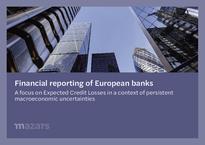
Financial reporting of European banks: benchmark study H1 2022
We have analysed the 2022 interim reports of 26 banks in 11 European countries to better understand the impact of macroeconomic uncertainties on Expected Credit Losses (ECL). This study is the fifth in its series and follows on our fourth edition of the report released in June 2022.
A focus on Expected Credit Losses
The study mainly focuses on the ECL-related impacts and covers:
- ECL charge impact of H1 2022 on the profit or loss and ECL allowances;
- ECL allowances: changes in coverage ratios and allocation between stages;
- Post-model adjustments/overlays;
- Forward-looking information;
- Ukraine war impacts on H1 2022 expected credit losses.
Read the report below to find out more.
In the following, our specialist for financial instruments, Heike Hartenberger, provides a contextualisation of the report for the German market:
"While the Covid-19 pandemic was a baptism by fire for the IFRS 9 ECL model in the 2020 financial year, overlapping crises now pose a new challenge not only for determining macroeconomic scenarios. The consequences of the war in Ukraine and the supply chains that are still disrupted due to the pandemic have resulted in ever-increasing costs, not only for energy and food. Banks as well as other entities are feeling the effects of growing inflation and rising interest rates affecting all areas of business, along with higher prices for raw materials, wage fluctuation, and changes in consumer behaviour.
Under IFRS 9, historical data and macroeconomic scenarios in particular form the basis for modeling the ECL. However, the scale and scope of both, the pandemic and the Ukraine war were extremely complex, making it difficult to predict and model. The development of credit risks in previous years can hardly be used to illustrate current developments. Changing correlations and expected volatilities are no longer comparable with prior years. The uncertainties about the future are difficult to capture in models. Therefore, overlays and management adjustments for credit risks are expected to overlap in fiscal year 2022 due to both the pandemic and the war in Ukraine."







